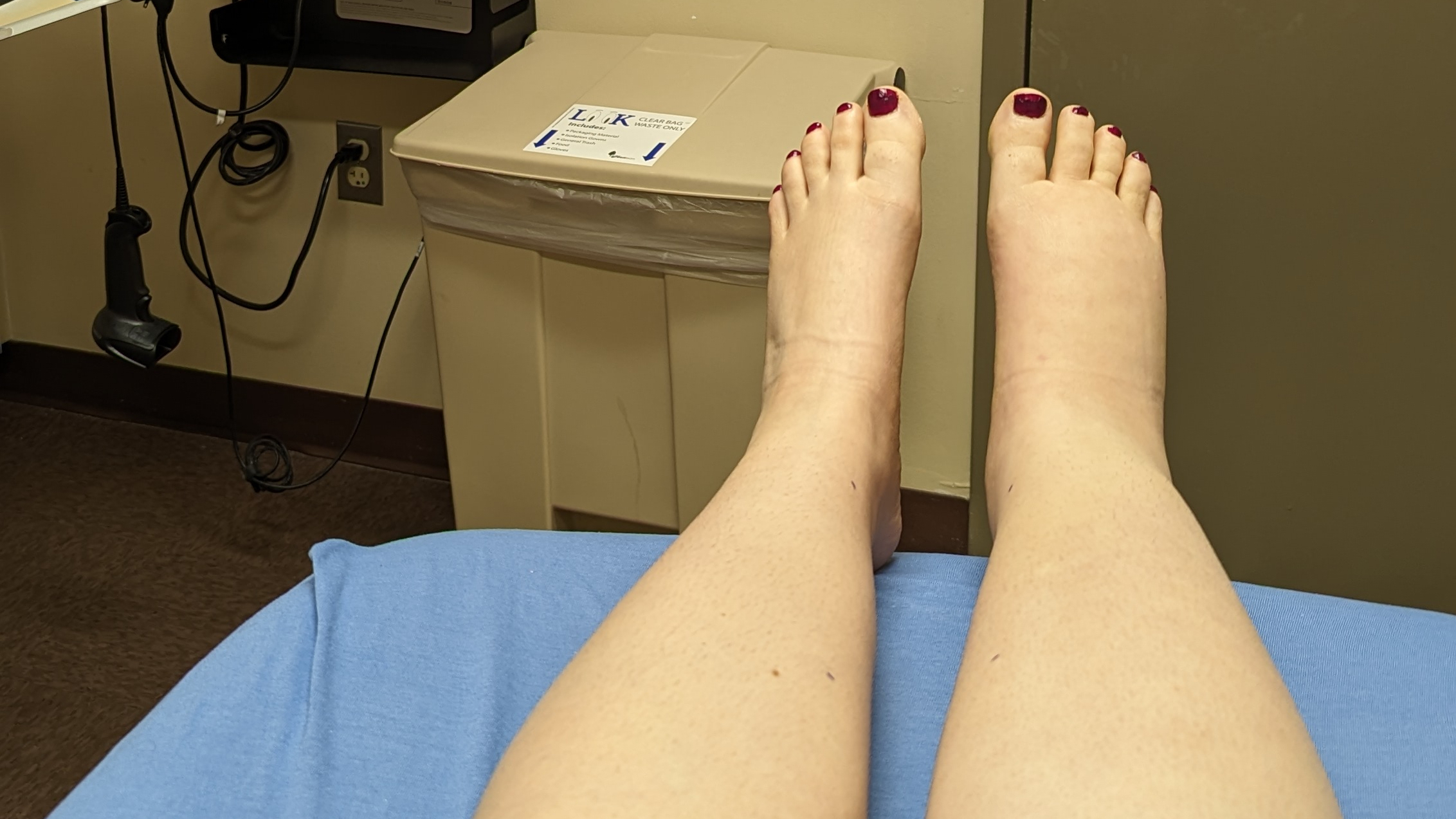Spots. I had spots.
I had just peeled off my compression garment only to reveal clusters of red, angry spots curling up my right leg like an unwanted vine. They first appeared earlier that morning after my shower: I shrugged it off as razor burn before slathering on some Eucerin and, once dry, pulling on my thigh-high stocking.
But now, hours later, they looked worse.
My thoughts immediately flickered to cellulitis, a bacterial infection of the skin and tissue. I never had it before, but having lymphedema puts a person at higher risk of this infection: our skin, thinned from being stretched by swelling, is an easy access point for bacteria, which then flourish in the protein-rich lymph. Our compromised lymphatic systems struggle to fight infection, and without treatment, cellulitis can quickly become serious. We’re talking hospital-admission-serious, with an IV of antibiotics, or else it can spread to the bloodstream and bones.
I ran my fingertips over the spots. They didn’t itch, nor did they feel hot or painful — the typical tells of cellulitis. It must be razor burn, I decided, or contact dermatitis from my garment.
Still…
I grabbed my phone and opened up a thread with two of my longtime lymphedema friends. “Hey ladies,” I wrote. “I need your lymphie wisdom.”
I typed out a quick summary of what was going on and asked if it was anything they’ve experienced or seen before, attached a photo of my polka-dotted leg, and hit “send.”
One of them responded that it looked like something she’d seen shared by a fellow member of the Lymphie Strong Facebook group and suggested I do a search for their name and the keyword “dermatitis”; sure enough, I found posts spanning a couple years where this person documented repeat occurrences of the rash.
It wasn’t dermatitis that she had, though but folliculitis — a condition where the hair follicles become inflamed or infected — and her photos looked a bit like my leg.
“See?” my boyfriend said, rubbing my back to reassure me. “That’s probably what it is — not cellulitis.”
“Yeah,” I waffled a little. It was around six o’clock at this point; the local urgent care was still open for a couple more hours. “I just want to be sure, though.”
He nodded: “Of course.”




As eager as I was to be seen by a medical professional, I was also nervous, dreading the inevitable lymphsplanation I’d have to give for my condition. If the doctor isn’t familiar with lymphedema, will they understand the gravity of the infection risk, or will they be dismissive of my concerns?
The whole car ride there I was rehearsing in my head: “I have a lymphatic condition that puts me at higher risk of cellulitis.” “My swelling is all lymph — it’s like a buffet for bacteria. Could this be cellulitis?” “I think this could maybe be cellulitis…”
When the doctor entered the exam room, I launched into my lymphedema elevator pitch. She listened while examining my leg.
“Yup, this looks like folliculitis,” she said. “You said you noticed it after shaving? Probably need to replace those blades.”
“I’m just nervous about infection, given my lymphedema,” I pressed.
“We’ll treat this like an infection, and prescribe you antibiotics,” she replied. “If this spreads beyond your knee, go to the hospital.”
I nodded to show I understood.
“It is odd, though, that it’s underneath your foot,” she paused, turning my foot to look at the spots on the sole. “Because there’s no hair follicles there.”
Once home, I took my first dose of the antibiotic. As my boyfriend and I sat on the couch watching TV, I started to shiver. I wrapped myself in a blanket and tried to relax until a wave a nausea hit me, fast and hard. I leapt up and ran into the bathroom.
I ended up vomiting twice that night. My boyfriend suggested it was because I took the antibiotic without food, but I protested: the bottle hadn’t specified to take with food. Maybe he was right, though… Or maybe this was a sign of something else?
I couldn’t think anymore at that point: I was physically exhausted from being sick, I was sweating, I had the chills. I told my boyfriend I was going to bed, and we kissed goodnight before I retreated into our room alone.
That night, I barely slept. I was simultaneously unbearably hot and freezing cold, and my leg felt tight and throbbing. I tossed and turned, the sheets twisting into a sweaty mess, as I whimpered in discomfort.
I teetered in and out of consciousness, but weaving through the fevered thoughts was a thread of certainty: This isn’t just folliculitis. This isn’t from the meds.
What is wrong with me?
The next morning, I asked my boyfriend if the room had felt warm to him; sometimes, if we neglect to crack the window, we overheat. Maybe that’s what had me so hot last night.
He shook his head “no,” and I mentally filed that away: Another symptom, possibly? Or me making something out of nothing?
Dazed, I made my way to the kitchen for some water. It was like I were a Slinky, loping around the apartment in slow, collapsing movements, pulled forward by gravity rather than my own energy.
It was a federal holiday — Presidents’ Day — so while my boyfriend had to go into work, I blessedly had the day off. After he left, I made myself a small breakfast before taking my morning dose of doxycycline and Googling images of cellulitis. The photos didn’t look quite like my leg, but they didn’t quite not look like my leg, either.
I wanted sleep. I wanted my leg to feel better. Instead, I stripped the bed and changed the sheets before stepping into the shower to rinse away the previous night’s misery from my aching body.
I gingerly washed my leg, the water pressure on my tender skin causing me to wince in pain.
Once clean, I climbed into bed, my cat curling up beside me, and finally slept.
Three hours later, I awoke and checked my leg. The spots had begun to spread into more of a splotchy rash, and the top and bottom of my foot were bright red. Was this improvement? I couldn’t tell, but I took a few photos to document it, just in case.
Later on, when my boyfriend got home, he gave my leg a look as well. “It’s definitely spreading,” he said, after examining the reddened skin under my foot. “The doctor said to watch if it spreads above your knee, but it looks like it’s spreading down.”





As my rash continued to spread, so did my concern.
Over the next couple days, the pain was such that I could no longer tolerate wearing my compression garment; without containment, my leg was ballooning, feeling heavy and tender. The only socks I could comfortably wear were the bariatric hospital socks leftover from my last course of complete decongestive therapy — everything else was too tight, the elastic bands cutting into my calf.
Not only that, but my head was pounding and foggy. Focusing on work, let alone being present in meetings, was a struggle. It felt like my whole body was fighting whatever was happening in my leg, and I was exhausted.
My loved ones, although supportive, were not comprehending my continuing uncertainty: I had the antibiotics, I just needed to stay the course and it will get better. I was beginning to feel like the protagonist of a Lifetime movie, desperately insisting that something wasn’t right, yet no one around me seeming to understand.
Enough was enough: This seemed like more than just folliculitis. I needed someone familiar with lymphedema to take a look. Even if it’s “fine” (i.e. not cellulitis), I could at least get some insights on how to manage my swelling until I can tolerate my garments again.
After a few phone calls, I learned my lymphedema clinic had a cancellation early Thursday morning — 7:40 AM. I took it.
At the clinic, I told the nurse practitioner the timeline of my symptoms, the urgent care visit, the chills and painful swelling. I showed him the photos documenting the progression of my leg over the last five days, and the bottle of doxycycline I’ve been taking.
“This is cellulitis,” he said, after examining my leg. “It’s good you got the antibiotics when you did, or else you may have ended up in the hospital.”
He told me the chills and sweats I experienced Sunday night were probably from cellulitis, too, and would have worsened over the next couple days if I hadn’t started the doxycycline so early on in the infection.
We talked about what to do next: Continue the course of antibiotics; elevate whenever possible; wear compression as tolerated. Once the cellulitis symptoms begin resolving, he said, I can begin using my pneumatic compression pump again. Oh — and no more shaving with a blade. An electric razor would be safer.
As I was collecting my things at the end of the appointment, the other nurse stopped me: “You were right to be so proactive going to urgent care and coming here,” she said. “It’s so important to listen to your body.”
I agreed, and thanked her. Settling into my seat on the bus ride home, I allowed myself to finally exhale. I felt validated: I knew something was wrong, even though what I was experiencing didn’t seem like the “usual” presentation of cellulitis.
Never ignore your lymphie intuition. Being proactive and advocating for myself is what kept me out of the hospital — and now I’ll know what to look for should I ever have cellulitis again.
Cellulitis: Know the Signs
Cellulitis is a serious bacterial skin infection that may enter via a break in the skin or an area of inflammation. People with lymphedema are particularly susceptible, therefore awareness and prevention are key.
Common Symptoms of Cellulitis
The Lymphoedema Support Network says you may often feel unwell at the beginning of a cellulitis episode, “as if flu is starting.” Symptoms can include fever, chills, muscle aches and pains, headache, nausea, and vomiting, while the affected area becomes red, warm, swollen, and tender to the touch.
Preventing Cellulitis
Skincare is an important factor in preventing cellulitis. Keeping the skin clean, dry, and well-moisturized helps protect you from breaks and minimizes the risk of infection.
When it comes to emollients, the International Lymphoedema Framework says, in general, ointments (which contain little or no water) are better skin hydrators than creams, which are better than lotions. Wait until the moisturizer is absorbed into the skin before donning your compression garments.
Treating Cellulitis
If you believe you have cellulitis, contact your doctor immediately as you will need antibiotic treatment. In addition to your antibiotics, you should elevate the limb, drink lots of water, and wear compression as tolerated. Do not perform manual lymphatic drainage or use your pneumatic compression pump until you’ve begun antibiotic treatment and the cellulitis symptoms have begun to resolve.
If you are prone to cellulitis infections, you may want to talk to your doctor about prescribing you an emergency supply of antibiotics that you can keep at home or bring along when traveling in case of need.
For more information, please refer to organizations such as the British Lymphology Society / Lymphoedema Support Network’s cellulitis guidelines or the International Lymphoedema Framework’s recommendations on best practices for the management of cellulitis, both of which include a list of antibiotics.
This fact sheet from the BC Lymphedema Association is another helpful resource for patients.



Leave a Reply